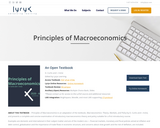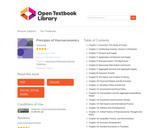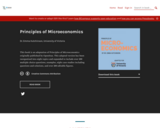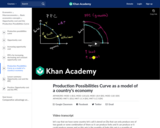
Explore what makes supply more or less elastic in this video.
- Subject:
- Economics
- Social and Behavioral Sciences
- Material Type:
- Lesson
- Provider:
- Khan Academy
- Provider Set:
- Khan Academy
- Author:
- Sal Khan
- Date Added:
- 08/10/2021

Explore what makes supply more or less elastic in this video.

Complements are goods that are consumed together. Substitutes are goods where you can consume one in place of the other. The prices of complementary or substitute goods also shift the demand curve. When the price of a good that complements a good decreases, then the quantity demanded of one increases and the demand for the other increases. When the price of a substitute good decreases, the quantity demanded for that good increases, but the demand for the good that it is being substituted for decreases. Take a deeper dive into how changes in the prices of complements and substitutes affect the demand curve in this video. Created by Sal Khan.

Principles of Accounting is designed to meet the scope and sequence requirements of a two-semester accounting course that covers the fundamentals of financial and managerial accounting. Due to the comprehensive nature of the material, we are offering the book in two volumes. This book is specifically designed to appeal to both accounting and non-accounting majors, exposing students to the core concepts of accounting in familiar ways to build a strong foundation that can be applied across business fields. Each chapter opens with a relatable real-life scenario for today’s college student. Thoughtfully designed examples are presented throughout each chapter, allowing students to build on emerging accounting knowledge. Concepts are further reinforced through applicable connections to more detailed business processes. Students are immersed in the “why” as well as the “how” aspects of accounting in order to reinforce concepts and promote comprehension over rote memorization.

By taking this free microeconomics course, you’ll be exposed to the economic way of thinking. You’ll understand how to use economics in your life and, ultimately, see the world differently.
We’ll cover fundamental microeconomics concepts like supply and demand and equilibrium. We’ll also answer questions such as: How are prices determined? What did Adam Smith mean when he said the market process works like an “invisible hand”? How is it that we have access to fresh roses in very chilly cities every Valentine’s Day? We will cover all the key topics including competition, monopoly, price discrimination, externalities, public goods and more.
There are no prerequisites to this course and it is accessible to a beginner.

Principles of Financial Accounting Book.

Principles of Macroeconomics is an adaptation of the text, Macroeconomics: Theory, Markets, and Policy by D. Curtis and I. Irvine, and presents a complete and concise examination of introductory macroeconomics theory and policy suitable for a first introductory course.
Examples are domestic and international in their subject matter and are of the modern era -- financial markets, monetary and fiscal policies aimed at inflation and debt control, globalization and the importance of trade flows in economic structure, and concerns about slow growth and the risk of deflation, are included.
This text is intended for a one-semester course, and can be used in a two-semester sequence with the companion text, Principles of Microeconomics. The three introductory chapters are common to both books.
Lyryx develops and supports open texts, with editorial services to adapt the text for each particular course. In addition, Lyryx provides content-specific formative online assessment, a wide variety of supplements, and in-house support available 7 days/week for both students and instructors.

Recognizing that a course in economics may seem daunting to some students, we have tried to make the writing clear and engaging. Clarity comes in part from the intuitive presentation style, but we have also integrated a number of pedagogical features that we believe make learning economic concepts and principles easier and more fun. These features are very student-focused. The chapters themselves are written using a “modular” format. In particular, chapters generally consist of three main content sections that break down a particular topic into manageable parts. Each content section contains not only an exposition of the material at hand but also learning objectives, summaries, examples, and problems. Each chapter is introduced with a story to motivate the material and each chapter ends with a wrap-up and additional problems. Our goal is to encourage active learning by including many examples and many problems of different types.

Principles of Macroeconomics Textbook.

Principles of Macroeconomics 2e covers the scope and sequence of most introductory economics courses. The text includes many current examples, which are handled in a politically equitable way. The outcome is a balanced approach to the theory and application of economics concepts. The second edition has been thoroughly revised to increase clarity, update data and current event impacts, and incorporate the feedback from many reviewers and adopters.
Changes made in Principles of Macroeconomics 2e are described in the preface and the transition guide to help instructors transition to the second edition. The first edition of Principles of Macroeconomics by OpenStax is available in web view here.

Principles of Microeconomics is an adaptation of the text, Microeconomics: Markets, Methods, and Models by D. Curtis and I. Irvine, which provides concise yet complete coverage of introductory microeconomic theory, application and policy in a Canadian and global environment.
This adaptation employs methods that use equations sparingly and do not utilize calculus. The key issues in most chapters are analyzed by introducing a numerical example or case study at the outset. Students are introduced immediately to the practice of taking a data set, examining it numerically, plotting it, and again analyzing the material in that form.
The end-of-chapter problems involve numerical and graphical analysis, and a small number of problems in each chapter involve solving simple linear equations (intersecting straight lines). However, a sufficient number of questions is provided for the student to test understanding of the material without working through that subset of questions.
This text is intended for a one-semester course, and can be used in a two-semester sequence with the companion text, Principles of Macroeconomics. The three introductory chapters are common to both books.
Lyryx develops and supports open texts, with editorial services to adapt the text for each particular course. In addition, Lyryx provides content-specific formative online assessment, a wide variety of supplements, and in-house support available 7 days/week for both students and instructors.

Jon Gruber elaborates the concept of microeconomics as scarcity. He explains and presents the modules of consumers and producers.

Principles of Microeconomics covers the scope and sequence of most introductory microeconomics courses. The text includes many current examples, which are handled in a politically equitable way. The outcome is a balanced approach to the theory and application of economics concepts.

Principles of Microeconomics is an introductory undergraduate course that teaches the fundamentals of microeconomics. This course introduces microeconomic concepts and analysis, supply and demand analysis, theories of the firm and individual behavior, competition and monopoly, and welfare economics. Students will also be introduced to the use of microeconomic applications to address problems in current economic policy throughout the semester.

An adapted version of the OpenStax Microeconomics open textbook, expanded with examples and concepts that are relevant to students at the University of Hawai'i.

This book is an adaptation of Principles of Microeconomics originally published by OpenStax. This adapted version has been reorganized into eight topics and expanded to include over 200 multiple choice questions, examples, eight case studies including questions and solutions, and over 200 editable figures.

The following question bank is written by Steven Stong. These questions have been using in a Principles of Microeconomics class that uses the OpenStax textbook Principles of Microeconomics 2e by Steven A. Greenlaw and David Shapiro.

Principles of Economics covers scope and sequence requirements for a two-semester introductory economics course. The authors take a balanced approach to micro- and macroeconomics, to both Keynesian and classical views, and to the theory and application of economics concepts. The text also includes many current examples, which are handled in a politically equitable way.

Two alleged criminals have been taken into custody. Will they remain loyal, or snitch each other out? Find out in this video! Created by Sal Khan.

Producer surplus is the difference between the price a producer gets and its marginal cost. This means the producer surplus is the difference between the supply curve and the price received. Created by Sal Khan.

In this video, Sal explains how the production possibilities curve model can be used to illustrate changes in a country's actual and potential level of output. Concepts covered include efficiency, inefficiency, economic growth and contraction, and recession. When an economy is in a recession, it is operating inside the PPC. When it is at full employment, it operates on the PPC.